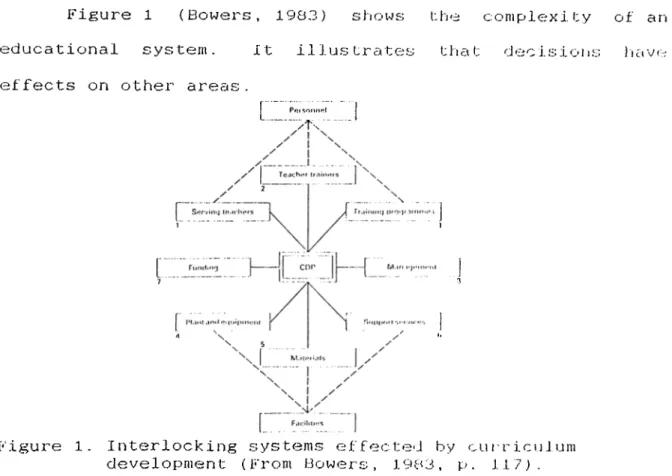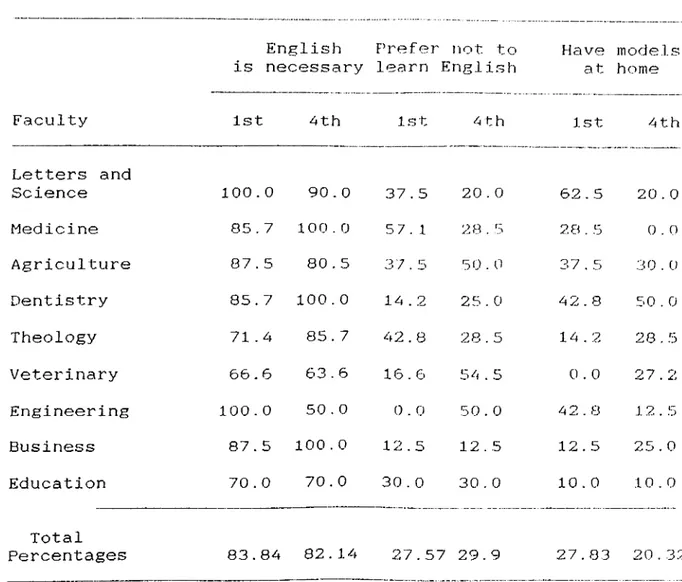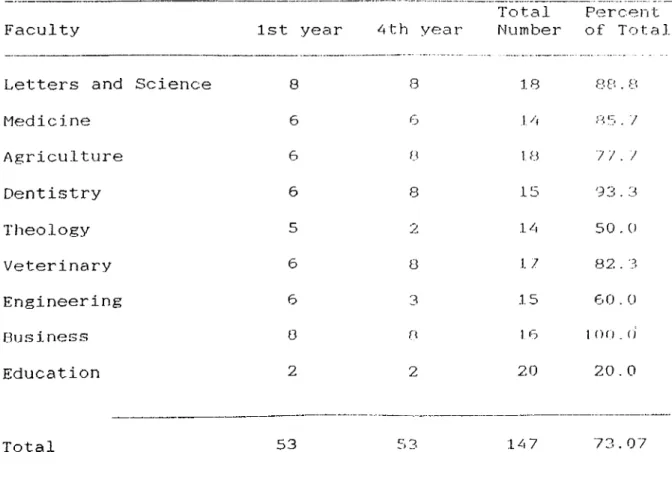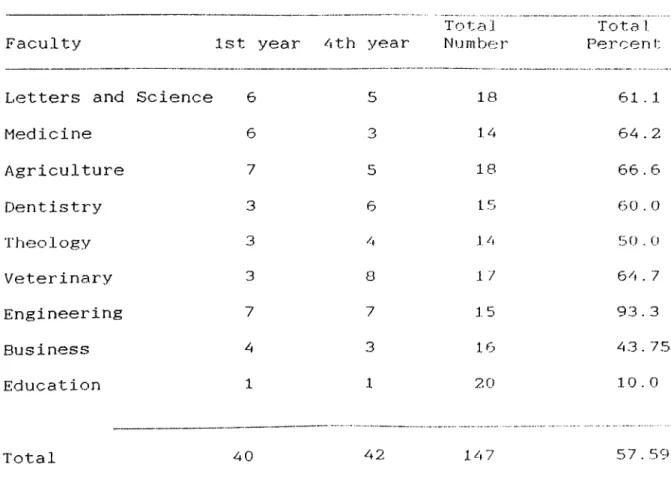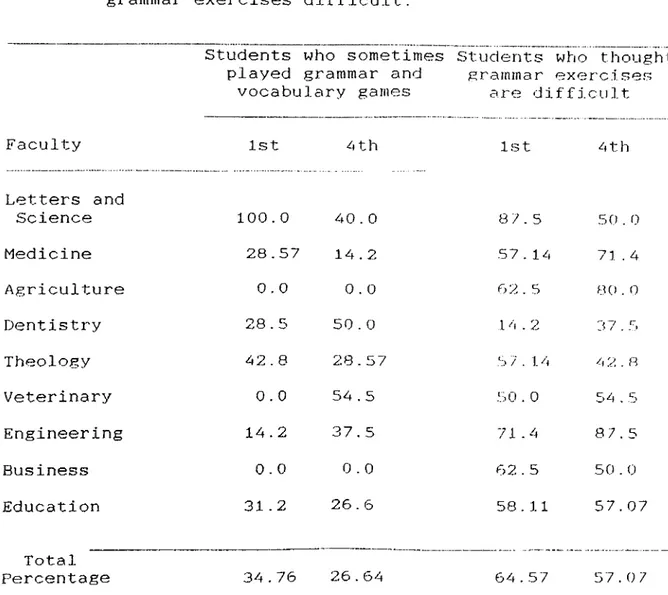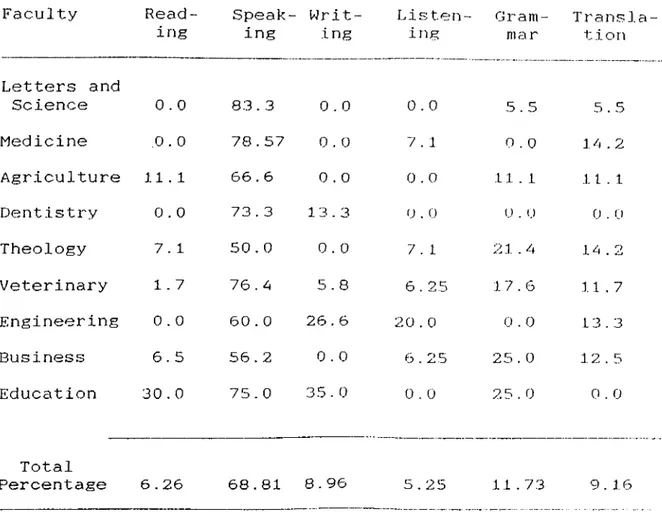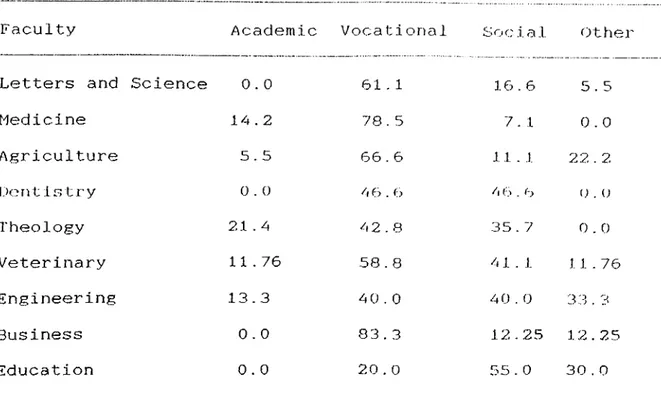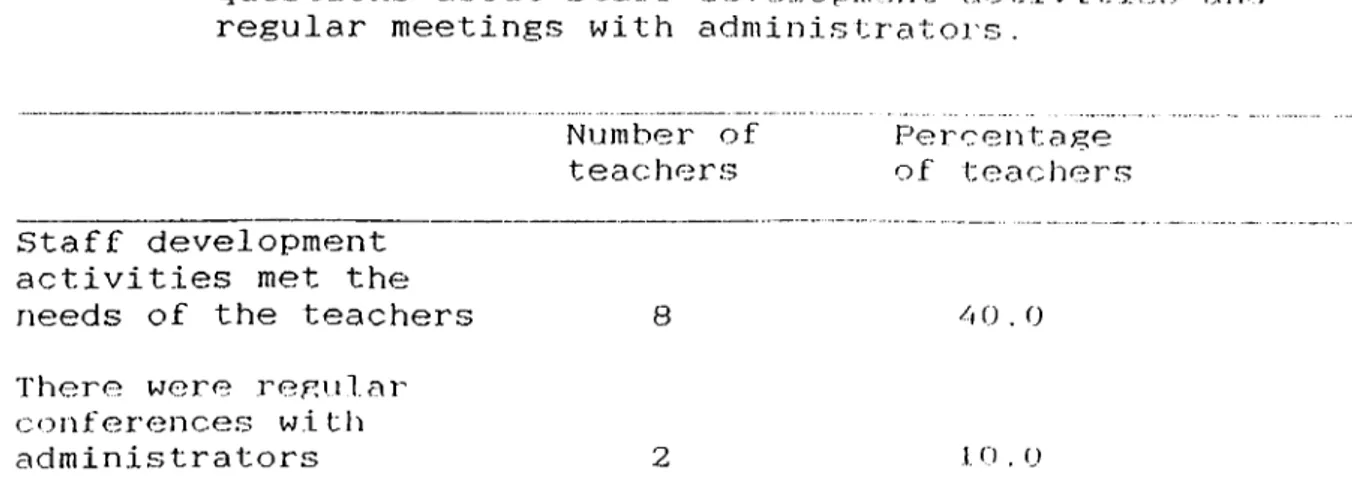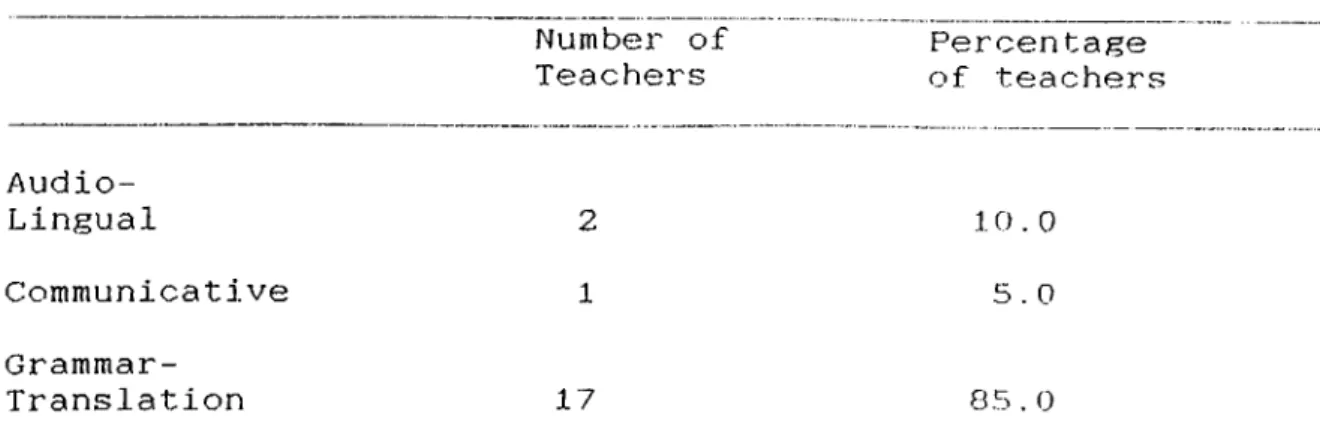MEEDS
m
THS
тв:отшмлюыв
of
thé
emölish
as
a
¥0швіт íMémjñm ш рлт ш т
дѵ
,
fiCTATtjñK im w B B B ïÎ Y
'*7“л ti··***v*'*^ л‘Ч ‘i г » U ¿ i S 'wi. La» ■ H Λύί** X ¿ ·, Ч»·» ¿ Uw '·* ..' ■ ■ .v;*·,/ *·^ ·νΛ ' - *.t .•‘.· 'u .J ''·^ ; ·;;.«■ i: V · · Í· >!i:vS j j»' '■ ·. ‘.ел '■> ; ή » 'vi * \ < » i. Ѵ.*,л. w sw ·.^. ; 3. .W « .m Ú''л i '.DNEEDS ASSESSMENT OF THE ORGANIZATION AND OPERATIONS OF THE ENGLISH AS A
FOREIGN LANGUAGE DEPARTMENT AT ATATÜRK UNIVERSITY
A THESIS
SUBMITTED TO THE FACULTY OF LETTERS
AND THE INSTITUTiE OF ECONOMICS AND SOCIAL SCIENCES OF BILKENT UNIVERSITY
IN PARTIAL FULFILLMENT OF THE REQUIREMENT FOR THE DEGREE OF MASTER OF ARTS IN THE TEACHING OF ENGLISH AS A FOREIGN LANGUAGE
BY
LEYLA TERCANLIOGLU August 1990
__1 · )r]Ik'Q
Pt
BILKENT UNIVERSITY
INSTITUTE OF ECONOMICS AND SOCIAL SCIENCES MA THESIS EXAMINATION RESULT FORM
August 13, 1990
The examining committe appointed by i.he
Institute of Economics and Social Sciences for the thesis examination of the MA TEFL student
LEYLA TERCANLIOGLU
has read the thesis of the student. The committee has decided that the thesis
of the student is satisfactory.
Thesis Title: Needs Assessment of the Organization and
Operations of the English as a Foreign Language Department at Atatürk University
Thesis Advisor: Dr. John. R. Aydelott
Bilkent University, MA TEFL Program
Committee Members: Dr. Aaron S. Carton
Bilkent University, MA TEFL Program Mr. William Ancker
We certify that we have read this thesis and that in our combined opinion it is fully adequate, in scope and
in quality, as a thesis for the degree of Master of
Arts .
A
John Aydelott (Advi sor)
Aaron Carton {Commi ttee Member)
U d
William Ancker (Committee Member)
Approved for the
Institute of Economics and Social Science
Bulent Bozkurt Dean, Faculty of Letters
I would like to express my deepest gratitute to
Dr. John R. Aydelott, iny thesis ■idvisor. for hi.s
invaluable support in making this thesi.s a realltv
I would like to express my thaiiks to Dr. Fer.sun Paykoc for her guidance in the initial stages of this thesis.
I am also indebted to Unal Peker who gave me the permission for using his printer.
ACKNOWLEDGEMENTS
TABLE OF CONTENTS
ACKNOWLEDGEMENTS LIST OF TABLES
CHAPTER 1: INTRODUCTION TO THE STUDY Statement of the Topic Statement of Purpose Statement of the Method Statement of Limitation Plan of Organization CHAPTER 2: LITERATURE REVIEW
Definitions
Educational Needs and Needs Assessment Methodology of Needs Assessment
Needs Assessment Studies in Turkey CHAPTER 3; METHODOLOGY
The Background
Objectives of the Study Selecting the Target Group
Designing Data Collection Instruments CHAPTER 4: PRESENTATION AND ANALYSIS OF DATA CHAPTER 5: SUMMARY AND CONCLUSIONS
BIBLIOGRAPHY APPENDICES RESUME 111 nI A 5 6 7 8 8 .18 2 3 30 35 35 36 36 37 43 6 8 71 75 83 IV
LIST OF TABLES
Page
Table 1: Percentage of students who thought Englisli
is necessary compared with those who prefer not to learn a foreign language and vjho had family members who knew English.
Table 2: Number of students who expected social and
vocational benefits from learning English.
Table 3: Percentage of students who were satisfied
with personal relations with their teachers and who liked the classroom that they used for English courses.
44
4 6
4 7
Table 4: Number of students who thought their teacher
should make some changes in their teaching. 49
Table 5: Percentage of students who said that they
sometimes played grammar and vocabulary games and who found grammar exei''ci.':e.s difficult.
Table 6: Percentage of students who ranked each
language skill as most important.
Table 7: Percentage of students who ranked each
language skill as least important.
Table 8: Percentage of students’ major purposes
in studying English.
52
53
Table 9: Number and percentage of teacher.s who
answered questions about staff development activities and regular meetings with
the administrators. 57
Table 10: Number and percentage of teachers who said students volunteered, were aware of why they were learning English and who used positive:
reinforcement. 58
Table 11: Number and percentage of teachers who checked the teaching method they most
CHAPTER 1
INTRODUCTION TO THE STUDY
Specification of language content has been the primary
focus in the traditional approaches to ioreign language
teaching. Also in traditional approaclies laiiguage «.urricu l.uni
development processes consist of the selection and sequencing of vocabulary and grammar underlying a specific method.
During the second half of this century a movement towards
behaviour-based and proficiency-based language curricula
began. As a result of this shift in perspective--known a.s
humanism--different formulations of the goals of language teaching occurred (Richards, 1984).
Since the beginning of the trend toward humanism, the
development of curricula that re.spond to the need.s and
interests of students has been receiving great attention. in
foreign language teaching, learner',s exf:)ecta i iorrs and des i rnr
have gained importance: every learner is accepted as ati
individual with unique characteristics, learning styles and
abilities.
In Turkey there is a great demand for learning English
for various purposes. Universities have various programs for-
teaching English. After the establishment of YÖK (Yüksek
Öğretim Kurumu) in 1982, foreign language departments were
organized and related directly to the rectors of
Atatürk University in Erzurum, Turkey, is one of these
programs. The purpose of this program is to teach English so
that the learners will be linguistically prepared to use western technology, to learn from major publications printed
in English, and to hold desirable joV.)s in the f\.iture. The
curriculum of this program is based on YÖK's regulations. The
students at Atatürk University may have different
characteristics from the learners of the other universities;
for this reason, an assessment of learner needs is essential
for developing the curricula in order to maximize i t.s
learning/teaching potential.
STATEMENT OF THE TOPIC
Founded in 1957, Atatürk University is a state
university. The Faculty of Letters and the Faculty of
Agriculture were the first faculties founded at thci
university. Today there are ten faculties with numerous
departments. The Department of English Language and
Literature, Faculty of Letters; the Department of English
Teacher Training, Kazim Karabekir Educational Faculty; and
the Department of English Language Teaching are the English
teaching programs at Atatürk University. This research
project focuses on the Department of English Language
Teaching which is related to the Rector and teaches English to the students of ten faculties.
Since this department serves two thirds of the total
student population of the university but has not planned its
own language teaching program, tliere is a strong need for a
practical basis for the English Language Teaching curriculum
which will satisfy the learners and teachers at Atatürk
University. This basis can be provided by a comprehensive
needs assessment which is one of the initial .steps in
curriculum development. Traditional approaches to curriculum
design began with language analysis. The curriculum
development process was based on such criteria a.s frequency,
teachability and availability of resources. Current
approaches use "needs analysis" as a starting point (Richards 1984).
This research project provides an as.sessment of needs related to the organizations and operation;? of English as a
Foreign Language Department. Curriculum developers can be
helped by an awareness of the needs of the individual
learners; they should be aware of the relationships among
teachers and students, and they should know the motives and
purposes students hold for studying English. The data on
student interests, teaching skills of teachers and
educational goals of the institution can contribute to the
accurate identification of the needs.
In light of findings of this study the areas that need
adjustment can be identified and the weaknesses in the:·
current situation can be discovered. If there is a gap
between the educational goals a program ha.s develoj^ed and its actual performance, there are unmet needs. Identification and
assessment of these needs should precede the goal setting stage of curriculum development (Bellon and Handler, 1982).
STATEMENT OF PURF’OSE
Needs a.ssessment is the most fundamental aspect of
developing a curriculum. The course designer begins the task
with needs assessment and then comes to the .stage of
materials development. The course designei' needs .some
Information on the characterictics of the target group in order to make decisions about what to teach and when to teach the selected content.
The focus of this study is on the identification of the gap between the goals of the program and the; perceived needs
of students. The identification of the needs is the first
step to determine the areas where the program has weaknesses in its goals. If there are weaknesses, before trying to solve
them, course designers have to know what they are and what
has caused the problem.
A needs assessment is necessary for developing a
curriculum appropriate to the needs of the students and
teachers at Atatürk Univer.sity. Because this project will
lead toward the improvement of learning, EFL learners,
teachers and administrators at Atatürk Univer.sity wi 1.1
STATEMENT OF THE METHOD
This research project has been conducted in four steps:
1. Literature has been reviewed to find working definitions
for the terms operations and organization as they relate to
educational programs. Ways to conduct neeids a.s.ses.sment, the
importance of needs assessment in the effective management of
educational programs and effective methods of curriculum
development for problem solving purposes are also dealt with in the review of literature.
2. Based on the findings of the literature review an original data collection instrument has been designed to examine needs, inter-relationships, motives and purposes of students, teachers and administrators of the EFL program at Atatürk
University. The questionnaire was distributed to the first
and fourth year students of the English as a Foreign Language Department.
This project includes teacher, student and
administrator comments and a partial status desciption of the? English as a Foreign Language Department.
3. The data were analyzed to discern if theie are any trends
or patterns in the opinions and attitudes and to determine if
attitudes and opinions are congruent with goals and
objectives of the program. The pre.sentation of the data
includes frequencies, averages, and percentages. Three main
research questions have been used as the basis for the
analysis of the data on organization and operations of the
1. What are the needs of students?
2. What are the relationships among teachers and students? 3. What are the motives and purposes of students
studying English?
4. Based on a comparison of the literature review and tlio
findings from the data collection, Implications and
suggestions were offered for the development/improvement of the organization and operations of the English as a Foreign Language Department at Atatürk University.
STATEMENT OF LIMITATION
The study is limited to the needs asses.sment of the
operations and organizations of the Eng’lisli as a Foreign
Language Department at AtatUrk University as they relate i:r,
student needs. From every faculty (Letters and Science,
Medicine, Theology, Dentistry, Engineering, Agriculture,
Business Administration, Veterinary, Education and Nursing
School) a sample class has been chosen and used as a data
source. No conclusions about the needs of students in other
language teaching programs in Turkey can be made on the basis of this study.
PLAN OF ORGANIZATION
The next chapter, Chapter 2 presents the review of
professional literature, it provided the study wltli
working definitions and concerned itseJ.f t.he i niiior i:oii' e r,f'
needs assessment in the effective management of educational programs and the methodology of needs assessment.
Chapter 3 describes how the researchc-jr collected and analyzed the data.
Chapter 4 presents and analyze.s the data.
Chapter 5 offers a summary of the .study, conclusions
and general implications for addressing learner needs as they
relate to the organizational concerns and operations of
Atatürk University. Thi.s research project concludes with the
comparison of the literature review and the findings on
Atatürk University; implications and suggestions were
CFIAPTER 2
LITERATURE REVIEW
This chapter is divided into four major sections.
First, the key terms are defined. Second, educational needs
and needs assessment are discussed; third, the methodology of
needs assessment is reviewed. Fourth, the literature on
Turkish program needs assessment.s is reviewed.
DEFINITIONS
In this section curriculum and four concept.s for
analyzing curriculum--goals, organizations, operations and
outcomes--are defined to provide background information for
the needs assessment research. The term needs assessment is
also defined.
1. Curriculum : There is a variety of definitions of
curriculum. These definitions range from a very strict
document specifing content to a very open, flexible
understanding of experiences. Saylor, Alexander and Lewis
(1974) define curriculum as a "plan for providing sets of
learning opportunities to achieve broad goals and related
specific objectives for an identifiable population served by
a school center" (p. 24). According tc· Deroche (1.981)
designed for the participants of the school. Needs of the
individual and the society form the content of the
curriculum. In addition. Robertson (1971) states the
f ollowing:
The curriculum includes the goals, objectives, content, processes, resources and means of evaluation of all the learning experiences planned for pupils both
in and out of the .school and community througl'i
classroom instruction and related programs (Yalden, 1987, p. 29).
Furthermore, Miller (1987) gives the description of
curriculum made by Eraut: "Curriculum is the set of broad
interrelated decisions about what is taught that characterize
the general framework within which teaching is planned and
learning takes place" (p. 4). Miller notes that curriculum is
less common in higher education. He places his definition in
the context of higher education: "Curriculum Is the total
planned learning program for any one student" (p. 4).
According to Deroche (1981), curriculum includes
programs and subjects specificially for the participants. I'he individual and society needs and contemporary influences form the content for the curriculum.
Weade (1987) believes that although curriculum and
instruction are defined separately, in practice they are
linked to each other. Weade adds that
"curriculum ' n ' instruction" is a dynami c process during wlri ch
students achieve both the social and academic content of a
lesson. In Weade's article one definition of curriculum is a
of curriculum posed by Weade is a "vital, moving, compl'ex,
interaction of people and things in a f ree-wlvvo Ling setting. "
The terms curriculum and syllabus are often oonf useiJ .
Weade (1988) states that curriculum should iiot be seen as a
"super syllabus.” She uses a house metaphor to clarify the
definition of curriculum. She says curriculum is like the
plan of the house yet to be constructed, a plan of how to
build the house, after it has been constructed and it is a
place where the people dwell. She says:
The conception of the house possessed by tho;
people living in it will be determined by tlie use they
make of the dwelling: does it match their 1 i.v,i irg
requirements, how do they use the spaces and f acl .1 ,i 1 ;j es
within the structure: what modifj.catlon might tiiey wani.
to make it conform more usefully to their retiui remerit.':;
(fj . a ; .
Posner and Rudnitsy (1978) say that there are many
definitions of curriculum and they avoid claimliig any
definition is the best one. But curriculum definitions make
important distinctions such as thstt between proces,ses and
products of planning and between curricular and instructional
matters. While distinguishing between the curriculum and
instruction theory Posner and Rudnitsky see curriculum as what is to be taught while the goals indicate what contcant is to be learned.
Richards (1984) says that althougii in both Britisli and
North American usage, in the broadest sense, curriculum
includes goals, content, implcamentation and evaluation of an
educational system; in its narrower sense, it refers to a
Curriculum has four major areas: .(^oal.s, organizations,
operations and outcomes. There is a close relationship among
these areas but there are important di.stinctions among them,
so they have to be discussed separately. Bellon and Handler
(1982) state that goals deal with the desired outcomes;
organizations with the resource.s, structures, communication
processes and programs; operations with the day to day
functioning of the program and outcomes with the intended or unintended program results.
2. Goals: Bellon and Handler (1982) define goals as
"timeless and nonmeasurable statements of desired outcomes"
(p. 25). They advocate that goal .statements should reflect
the values of the participants who are directly affected by
the educational program. Each program should have a purpose.
By the help of clear goal statements, programs can establish
the desired sense of purpose. Educational goals are future
oriented and they help organiza tion.s develop plans for
meeting current and future needs.
Moreover, Miller (1987) uses Davies' (1976) metaphors
to clarify the distinction among aims, objectives and goals.
Davies pictures an aim as a starting point and direction, objectives as a series of signposts or milestones of achieve
ment and the goal as the final destination. Posner and
Budnitsky (1978) define goals as the attributes of the
educated person.
In the discussions about goals and goal setting
Educational needs are seen as an important data source for the establishment of goals (Bellon and Handler, 1982). Bellon and Handler (1982) present these points to provide a frame of reference before establishing and asse.ssing goals:
processes, the term educational_needs Is oft6>n used.
- Goal statements should represent the values of all appropriate client groups.
- The process of generating and agreeing upon
educational goals should be designed to help school.^ become renewing and future oriented organisations. - Priority levels of educational goals should be used
as a basis for decision making.
- Educational goals should be writteii, made public.,
and evaluated on a regular basis (p p. 26-28).
3. Organizations: The description of organizational factor.s
and influences (Bellon and Handler, 1982) have great
importance in the development of curriculum. Organizational
consideration.s include all resources in the organizations,
the structural relationships, the processes which are
essential in organizational functioning, and the programs.
Among the resources are human resources, physical resources,
financial resources and time resources. Human resources are
the most important resources. In education time is a critical
resource. Guntermann (1987) says that time is the most
serious element among the variables affecting foreign
language program design. Arrangement of these resources form the structure of the organization.
There are several processes wlvich influence how an
organization functions. The mo.st important of these processes
the planning process.
Goals give direction and F)urpose to the activities conducted by the participants in the organization. To support
these activities resources are needed. It is essential to
arrange these resources. According to Bellon and Handler
(1982) there are various programs in an organization. They
say "A program can be defined as a set of goals and specific
objectives with the resources necessary to reach the
objectives” (p. 39).
Bellon and Handler (198.2) summarize the propositions
which are based on the findings and assumptions about
organizations:
- Participants in an organization should place a high priority on developing unity of purpose.
- Participants in an organization should have the opportunity to achieve their personal goal.s as well as tho.se of the organization.
- Even though there are formal hierarchicial
relationships to organizational structure, it is possible to capitilize on the capabilities of all participants.
- Organizations must have mechani.sims for generating information to support feedback and decision making
activities (pp. 40-43).
White (1988) states that there are various effects and
forces which operate within a system. He gives the definition of system made by Miles (1964:13). Accordingly, system is a collection of independent parts for the accompli.shment of
some goals. These independent parts are maintained in a
Figure 1 (Bowers, 1983) shows; the complexity of an
educational system. It illustrates that decisions have
effects on other areas.
Pf>tsofiM»;l
--- ...
Figure 1. Interlocking systems effected by curriculum development (From Bowers, 1983, p. 117).
Although there is need for organ iza i; ional eva lua tic>n ,
little attention lias; been paid in previous evaluation
frameworks. Program planning and budgeting systenrs (PPU.S)
provide useful information related to organizational
evaluation. The PPBS format put.s emphasis on or.ganiza t ional
considerations. Hammond (1973) ofler.s r;b .·<, M v( ;.s whi'h aic'
based on an evaluation framework and identifies important
institutional variables (Bellon and Handler, 1982).
A. Operations: This phase of development and fivaJuation
deals with the decisions related to curric;ulum and
instruction. The main concern is the day-to-day functioning
Instructional transaction is a useful concept at the operations level. Instructional transaction includes specific
objectives, activities and materials. These transactions are
carried out on a day-to-day basis. There should be a clear
relationship between the instructional transactions and
important educational goals. The.se transactions should focuis
on student learning. There is a diversity of opinion about
how to state and use objectives. Here are the assumptions
about operations.
- The day to day operation of the school or district should reflect a consistent and unifying focus on goal attaintment.
- Student learning should be the primary focus for day to day operations.
- Instructional improvement .should be a systematic, high priority operations activity guided by positive assumptions about teacher behaviour.
- Administrators at the building level have a major leadership role with respect to operations activities
(Bellon and Handler, 1982, p p . 53-57).
Process evaluation is regarded as a necessary step to
help to overcome operational difficulties. Regular feedback
on program Implementation should be provided (Bellon and
Handler, 1982).
5. Outcomes : According to Bellon and Handler (1982) outcomes
are more than measurable changes in learner knowledge and
skills. It is possible to define outcomes as the "effects of
a program on the participants and on the educational setting
in which the program operates" (p. 67). In thi.s definition
and psychomotor outcomes as well as cognitive ones. Affective
outcomes emphasize such feelings and emotions as interests,
attitudes and methods of adjustment. Psychomotor skills such
as handwriting, typing, computer using and operating
machinery are also important outcomes.
Generally in curriculum planning ].il;tl.e emphasi.s J .s
paid to motivation and self concept. Outcomes have primary
importance for the learner but outcomes are not only the
things which happen to the learner. Since the learner is not
the only participant in the educational program, other
participants (teachers, admlni.strator.s) .sliould al.so be
included in the examination of the outcome.s. If the learners
have negative attitudes as a result of exce.ssive work then the teacher or program cannot be judged a success even if the
students score well on examinations. To meet goals
alternative ways must be developed.
Bellon and Handler (1982) suggest "This view of
outcomes reduces the likelihood that all major program
effects will be evident in a particular time" (p. 68). These stages of curriculum should be considered:
- The status study should reveal both past and present outcomes and ways that they have been measured,
- The development and evaluation process should generate data about interim outcomes,
- Data should be gathered concerning long term program
effects. (Bellon and Handler, 1982, p. 68)
- Those responsible for planning and carrying out educational programs view accountability for
educational outcomes as an important influence in improvement efforts,
- Objectivity should be sought and maintained in assessing program outcomes,
- Cost-benefit analysis and comparative analysis should be used sparingly and with caution (pp. 69-70).
6. Needs assessment .· According to Saylor, Alexandei:' and
Lewis’ definition (.1974), needs assesment 1;:·· .a teclmique for'
identifying those educational objectives which most need to
be accomplished in a given instructional situation. To
Savignon (1983), needs assessment is a survey of learner
needs and a basis for curriculum and/or materials
development.
Since needs assessment provide.s a basis for deci.sions, it is the fundamental aspect of curriculum. It is the initial
stage of the course plarming procedure. The.se activitie.s
should be included in the needs assessment design:
- identification of the source for data collection - developing procedures for collecting the data,
- establishing procedures for analysing the data that have been collected,
- determination of needs assessment priorities, - reporting the results of the assessment
(Smith, 1989, pp. 8-9).
Mackay and Bosquet (1981) suggest that there are levels
in the field of decision making. Decision making involves
individuals, politicians, educators, curriculum planners,
materials, writers, teacher trainers, school principals,
teachers, evaluators and researchers. In educational decision
program development stage and program maintenance and quaJ.ity
control stage. The first stage is accompj i.shed by the
administators in authority. The program development stage
involves information about constraints and the potential
resources.
Dubin and Olshtain (1986) state that the process for
describing the current status of a program provides the basis
for needs assessment and provides answers for the.se key
questions:
Who are the learners? Who are the teachers?
Why is the program necessary?
Where will the program be implemented? How it will be implemented? (p. 5)
Dubin and Olshtain (1986) assert that to know the actual
consumers of a new program, thorough attention should be
given to needs assessment.
EDUCATIONAL NEEDS AND NEEDS ASSESSMENT
1. Educational needs: According to Posner and Rudnitsky
(1978) a course rationale is composed of three components:
the learner, the society and the subject matter. Since the
learner is in the center of the teaching in learner-centered teaching, values regarding the learner are the most important "data sources" for the program.
There are great differences among ]earner.s. Needs,
other. Learners have different purposes In Jeat-nlng Engllsli.
Educators have turned their attention to the needs of the
learners. According to Birckbichler and Omaggio (1978),
students have different preferences and different learning
styles: all students adapt their own learning strategies as
they learn a second language.
Bellon and Handler (1982) define educational needs as the differences between the actual and desired performance. To Bellon and Handler it is essential to set the goal.s on the
most accurate and up-to-date basis. Von Der Handt (1983)
regards needs assessment as the necessary first step of constructing curriculum.
According to White (1988), Taba (1962) sees educational
needs as a criteria for setting objectives. The learner has
needs both as an individual and as a member of society. Since
the society makes demands on the individual learners, these
needs should be included in needs assessment studies.
Savignon (1983) advocates that all curriculum designs
begin with needs assessment. She divides needs assessment
into two groups: immediate and specific needs and non
immediate and varied needs. For example, university students
enrolled in a specialized course of studies have immediate
and specific needs. On the contrary learners in traditional
schools have non immediate and varied needs. She states that
secondary school students, even college or university
students often have no immediate use for a second language
instrumental purposes of meeting university entrance or graduation requirements.
Martins-Baltar (in Porcher, 1983a) distinguishes three levels of needs:
- Why does a person learn a language?
- What language competencies must the; learner have?
- To acquire competency what kind of knowledge must the teacher teach? (p. 22)
Scharer (1983) offers three important points to be considered:
- Educational needs change from student to student - Needs change within the teaching/learning process - Different people are involved in this task
In contrast, Porcher (1983b) make.'S the definition of
need as the distance between what a learner is at present and
what he should become as too restrictive (p. 129). He say.s
that a need is never a "closed book." It includes both
present and the future. A learner has motivations,
expectations and intere.sts at pre.sent and the J.earner has an
image of the future. The present influence.s the future. A
learner's present sociological circumstance influences the
his image of the future. If the learner has a clear
conception of what can be done with this knowledge, he can
learn easier. The relations between the student and what the
student is learning are important in the identification and
analysis of learner needs. The learner's attitude toward
2. Needs__assessment: Porcher (,1983b) asl’:s three important
questions which require answers in all learner-center'Cfl
language teaching programs:
1 - What are the essential characteristics of the members of the target group?
2 - What should be offered to the learners to give them a language ability in conformity with their aims?
3 - What is the learner and what does the learner want to
become? (p. i29)
In a learner-centered program it is meaningless to
separate the learner from his needs. Ignoring needs can put
psychological barriers between the learner and the learning. According to Hoadley-Maidment (1983) the obiectives of a needs identification study are as follows:
- Needs identification contributes to a more accurate assessment of learner needs before planning a course. - Needs identification contributes to the assessment of
the learners language needs and present proficiency level.
- Needs identification contribute.s to the examination of the patterns to overcome cross-cultural difficulties. - Identification provides a data basa for materials
development in the area of student autonomy and self-study skills.
- It provide.s a method to increase student autonomy by getting students aware of their needs.
- It helps to the integration of all methods and findings into general classoom as quickly as
possible (p . 40).
Rodrigues (1983) asserts that because of learning
conditions the requirements of curricula can be satisfied
rarely in practice, the needs and expectations of the learner should be taken into account. He points out the importance of discovering the most essential needs that must be given
three questions:
- What use can the learning of foreign languages be to the pupils?
- What do they think of language learning?
- What do their families, teachers, employers think? (p. 56) According to Bell's training model, there are ten steps in the design of a training program; identification of the
needs is the first step. Identification of needs serves tlie
purpose of determining objectives (White, 1988).
To point out the importance of identification of needs Richterich (1983) claims that:
If the learners learn badly, are uninterested in their studies, lack motivation, find tiiaching boring and without Interest and do not put enough into their
work, it is largely because the educational content,
methods and practices are ill-adapted to the various
types of learners and take no account of tlieir
differences and pecularities (p. 2).
Richterich (1983) says that to be able to overcome
these difficulties it is essential to relate teaching to
Individuals and to match the content, methods and practices to the characteristics and abilities of tlie learner:
- to do this, it is essential in the first place to determine objectives accurately.
- we are therefore obliged to acquire better
understanding of the capabilities and resources of the target group concerned.
- the identification of language needs thus becomes a sine qua non of all learner-centered teaching and of all learning which is matched to the learner's
resources, expectations and interests (p. 2).
If the course designers do not pay attention to the
setting syllabus objectives both the needs and wants as perceived by the participants and the resources available
should be considered (Dubin and Olstain, 1986, p. 102).
Additionally, Pi.er.son and Fri 1'-It.'··. Moni, ) regard need.s
assessment as a helpful planning guide.
METHODOLOGY OF NEEDS ASSESSMENT
In needs assessment studie.s it i.s nece.s.sary to c<'' l I'-ot
information from a relatively large number of petrsons. The
reason for information gathering is to understand th€i
learners and to identify the present conditions of the
organizations. Thus the data collection instruments must be
carefully selected. In some case.s the data can be readily
available from school records, admi.s.sion offices or from the
records held by students. But if the needed information is
not obtained from the records it is necessary to construct
instruments to obtain data.
Needs survey is the way to gather information about the
target group. Generally needs ana,l.ysi.s follows the
**'^· l i H » J s t w u p ¿ 9 l i U t l i · ! » . . l b
essential to compile information before establishing
realistic objectives in the revision of an existing program.
Savignon (1983) says that a needs survey may serve in
different ways to " confirm impre.ssions of learners'
(p. 126). But in both ca.ses the aim of tlie need.';: .'survey is to
help to develop a more responsive program l:<;> l;he learner
needs. In the beginning, it is better to identify the reasons for conducting a need.s analy.sis.
Richterich (1983) suggest.s that all needs as.ses.sment
.studies begin with the same operations;
a - collecting information
b - explaining the information in order to make choices and decisions
He presents some question.s and he note.s that these question.s are unavoidable as the study become complicated.
- who decides to identify needs? - who collects the information? - what information?
- on whom? - how
- where and when?
- who will use the information? - how?
- to do what? - in what form?
- what is the relation between the cost of the information and its usefulness/effectiveness. - how to assess the whole identification procedure
(p. 1)
About the assessment procedure he asserts that there is
no one, universal methodology bi.it several met:h'->dologie.s .
There are various data collection techniques proposed by
various authors. But the choice of the technique to be used
depends on the context.
Yalden (1987) suggests the following techniciues for
gathering data: classroom ob.servation , d iscu.ss J on ,
2. Classroom observation provides a tool for observing the;
educational process (Porcher, 1983). it is generally used in
organizational development and evaluation pj'ooe.s.ses. The
observer can observe and make note of resources of tlie
program and try to find out if the facilities are adequate
and if they meet the needs of the learners. Yalden (1987)
points out that when used to document resources the
observation does not require any explanation.
A checklist is very u.seful in collecting observational
information. If the teacher has a checklist, the teacher can
begin to fill in the blanks from the beginning of the cour.se. Checklists produce d ' ta that are usually easy to summarize.
2. Discussion give people a chance to expre.ss their opinion.s
on a topic. They may be structured or un.strucl;ured , but it i.s
hard to analyze unstructured discussions. In a study on
migrant workers learning French, Porcher (1983) uses
discussions both with the institutions and with the teachers. He learned from the institution about the? position of the
teacher, teaching time-table, teaching aids usually used and
tihittif * i(. H ¡4 W i fcf M i'h iS ,i.sa|iiir?’ii*4i·· - rUtH· M i ^ w'f· WUS> M' t lUi ·<(·(<»<
teacher, the researcher asked questions to know what
educational methods the teacher used, what the teacher's
objectives were, how the teacher used the learner's needs and
how the learner would make use of what they learned, how the
relation between the learners and collègues were and wliai
(1983a) talked to the learners, and asked the following questions:
- Did they expect any social and vocational benefit from their education?
- What was the age range in the class?
- How good was their present level attainment?
-- How closely related was their mother tongue
to French?
- What level of attainment were they Jooking for?
- Were they satisfied with the teaching? (p.l9)
3. Questionnaire: According to Llcari, Londel and Mandolini
(1983), the purpose of preparing a questionnaire is to
prepar'e the ground for a possible reorganis.ai J.ori of service.s.
The identification of learners ' needs can be carr i<:;d out Ijy
questionnaires. Licari, Londei and Mandolini (1983) .suggest
that in the l.ight of the in forma i'i'''n |ii'':'Vide'i by thi,·
questionnaire, the courses could be reoriented in respect to
matters such a s :
time and frequency course content the target skills
general and specific proficiency (p. 91)
Licari, Londei and Mandolini (1983) suggest the.se
stages of a questionnaire:
1 - Preparation of a questionnaire
a - Regular meetings of working party b - reading bibliographical re.search c - statistics of enrollment forms d - first draft
e - consultations with sociolinguists and psycholinguists f - meeting with the teacher
g - second and last draft
2 - Distribution of the questionnaire
a - instruction to the teacher
b - presentation of questionnaires to the class 3 - Data processing
a - coding
b - transfer to punched cards c - programming
d - results according to frequency distribution of var iable; 4 - Meeting of the working party and analysis of data
5 - Qualitative data
a - meetings at the meeting party
b - consultation with sociolinguists and psycholinguists c - meeting with teacher
6 - Consolidation and drafting of final report (p p . 92-93).
Licarl, Londei and Mandolini (.1983) divide their
questionnaire into four parts. The first section is concerned with the identification of the learners, description of thei.r
family and socio-occupat ional language I'cckground. Tlr·
personal details of the learner.s are included in itiis
section. The second and third section.s are the most important sections of the questionnaire. These sections deal with tlie
problems of language communication and the socio-cultural
image of the language chosen. The fourth section is designed
to assess the association's ability to meet the expectatioirs of the target group.
Rodrigue.s (1983) suggests that que.stionna ires can
provide very interesting answers on:
the choice of language (whicli/why) what purpo.se they thought learn.ing it the materials used
motivation
activities performed (p. 57)
could serve
Yalden (1987) asserts that to develop a course which
meets the pupils' communication needs in the tar,get language,
it is necessary to find out more about the learners.
Questions in a questionnaire can be about the background of the learner, their learning styles and language needs.
According to Mackay and Bosquet (1983) questionnaires
allow open-ended questions to be included, but it may be
difficult to analyze and compare the responses to open-ended questions.
· Interview: Hoadley (1983) used mother tongue interviews to
minimize linguistic interferences in her study. She
emphasizes the importance of repeating the interviews to
identify needs. She conducted the interviews a i: four stages :
Pre-cour.se, mid course, end of cour;;e and fr.iui' s>r five nioiiMir·
later. .She u.sed the dc\ta col lectori ai Mk· pr o -cr>i,i r.se .sec.lion
in syllabus planning. She compiled the mid-course data for
both evaluative and diagnostic functions. The data had a
counselling effect. End-of course data had an evaluative
effect.
Rodrigues (1983) interviewed the pupils, parent.s
and administrative boards. He writes:
These interviews were also very useful in giving us the opportunity of speaking to all concerned in the experiment in a more relaxed atmosphere and r^f getting
to know the difficulties encount6;red, the successes
obtained and any failures suffered. This helped us
greatly to assess the progress of the work. (p. .37)
Mackay and Bosquet (1987) exr:ilain that structured
interviews can explain incompletely understood responses if
necessary, but they require a lot of time. Like
questionnaires interview.s allow open-ended question.s to be
In conclusion, data can be collected i lirough obtrusive
atid unol.)l;ru!''J VO ways. Ol.i!;'ri'v,.> i. i f.-ti;: , i11 lv;i'v 1' .-u;: ,
questionnaires and discussions are obtrusive data collection
techniques. Unobtrusive measures such as document analysis--
school records, enrollment figures, grades, test scores,
student profiles, records concerning student profiles,
records concerning student attendance, transfers and dropouts and financial records including the amount spent per student
and the amount spent for materials--can be very useful in
analysing the needs of students .and llı<,·)r pa 1.1-: r n;·; f.f
NEEDS ASSESSMENT STUDIES IN TURKEY
This section is devoted to the review of the needs
assessment studies in EFL programs in Tut'key.
The fact is that literature on needs assessment: :i n EEl,
programs in Turkey is limited. The needs assessment studies
conducted by Göksel (1987) and Ok (1986), although are not
closely related to the topic of this study, are some of the
few examples of needs assessment studies in Educational
Sciences in Turkey.
A_study on the inservice trainin g n e e d s o f T u rkish elementary school teachers as perceived by e-ilementary school
supervisors.__ principals and teachers by Göksel (1986) deals
with the differences of agreement among elementary school
supervisors, principals and teachers regarding inservice
training needs of elementary school teachers. This study
includes 25 elementary school supervi.sors, .24 elementary
school principals and 315 elementary school te;acher.s. A.s a
needs assessment instrument a questionnaire was designed and the data were analyzed by using statistical tests.
According to these results of Göksel ' s study, tlie
target group agree.s that there is a need for elementai'v
school teacher inservice education but they do not agree in
the magnitude of these needs. Göksel (1987) gives two
First, since in-service training is a very compleK phenomena and depends on various factors, the results of the studies carried out in different; countries cannot be generalizable (p. 96).
The factors which inservice training depends on
are listed in Göksel's study. These factors are geo,graphical
location, cultural features of the country, socio-political
organization of educational activitie.s, financial resources
allocated to education, and characteristics of those Involved in educational activities. Göksel continues:
Secondly, inservice training activities in Turkey have been newly organized. They are not based on the empirical data obtained from both teachers and
administrators (p. 96).
The results of Göksel's study reveal that there are
differences between supervisors and principals, and
supervisors and teachers. Teachers and principals feel the
necessity of training in student-related areas. Teachers and
principals want their immediate needs to be met.
It was seen that level of experience among supervisors and principals does not have any significant effect on their perceptions of inservlce training need.s of elementary school
teachers. The level of experience among teachers has
importance in terms of methodology, classroom activities,
discipline and exploiting the sources. In addition, it was
proved that location of schools in high, middle or low socio
economic status districts does not affect the teachers'
perceptions about their inservice training needs.
The first study was conducted by Basaran (1966).
Basaran (1966) conducted the study to determine the problems
of inservice education of teachers and the needs of the
teachers. The following problems are stated by Basaran;
1. In most of the inservice training activities, programs
have not been relevant to the actual intere.sts and needs of teachers.
2. In planning inservice education activities, precautions
have not been taken in order to remove the problem.s
which directly or indirectly influence the activities,
or it has not been known how to solve the.se problem.s.
3. To what extent the.se problems lead to ineffectiveness
or failure in inservice education activltie.s has not been known, and therefore, it has not been po.s.sibl.e to find solutions.
4. Since which inservice training techniques teachers
mostly prefer and perceive to be useful is not known, they have not been used appropriately, which leads to ineffective and unsatisfactory inservice education activities.
5. In most cases, in-service training techniques have
not been used appropriately, which makes the activitie.s useless and decreases the efficiency. The primary reason for this is that teaching staff have not been equipped with sufficient knowledge about how to use them.
6. Teachers' experiences, their preservice education
grade level types of school they teach and positions they hold Influence their attitudes towards inservlce
education, and their needs and interests to a great extent [sic] (Göksel, 1987, pp. 52-53).
Göksel (1987) refers to another study done by Canman
(1979) on the present status and the problems of the
inservice training in the General Administrative
Organizations and State Economic Enterprises in Turkey. He
proposed some ways for the Improvement of both the inservice training activities and the methods of evaluation of the programs.
A study on the determination of_teacher s ' perceived training needs in relation to student perception of .teaciier behaviours and teachers branch was conducted by Ok (1986). He explains the purpose of the study as follows.·
The purpose of this study was to determine
teachers' perceived training needs and to relate these needs to student perception of teacher behaviour and teachers' branch (p. iii).
Ok (1986) chose two sample groups for this study: Ankara
Turk Eğitim Derneği and Ankara Atatürk Anadolu Lisesi.
Twenty-seven teachers who taught in Lycee II, and 444 Lycee
II students of the indicated schools were included in this
study. Questionnaires were designed for both teachers and
students.
In this study Ok (1986) deals with four problems: 1. Finding out teacher' perceived training needs.
2. Handling teachers' branch as an independent variable.
3. Examining the agreement between the student perception of teacher behaviour and the teacher perceived training
needs.
4. The effectiveness of the Delphi technique in the
determination of needs of the teachers who participated in the study.
While discussing the findings the researcher says that the data analysis revealed that all of the teachers who participated in this study accepted the importance of some of the characteristics and behaviours that need to be developed through teacher training programs. Ok (1986) says:
The quantitative and quaiitative analysis of students' ratings also indicated that they rated
teacher behaviours about which they were not very clear lower the scale and they did the opposite for those behaviours about which they were clear (p. 82).
SUMMARY
This chapter first offered the definitions of the key
terms: curriculum . its four concepts, and needs assessment.
Definitions of the four concepts of curriculum---goals,
organizations, operations and outcomes--were based on the
Bellon and Handler framework (1982) for curriculum
development and evaluation. A discussion of educational needs
and needs assessment was followed by the review of
methodology of needs assessment. The literature concerning
needs assessment studies in Turkey was also reviewed but it was seen that very little research about needs assessment exists in EFL in Turkey.
